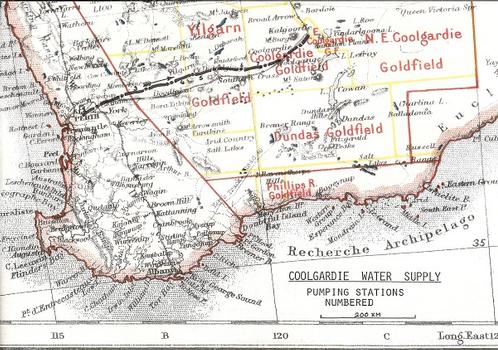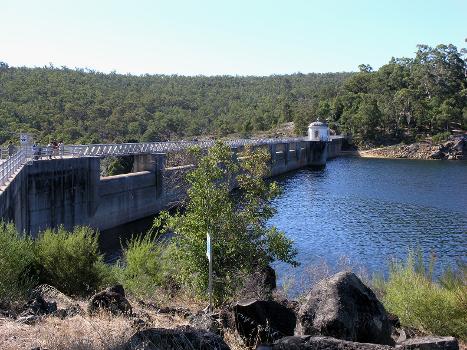General Information
Project Type
| Function / usage: |
Aqueduct |
|---|
Awards and Distinctions
| 1987 |
for registered users |
|---|
Location
| km | Name |
Technical Information
Dimensions
| total length | 557 km |
Chronology
| 1898 | Construction started. |
|---|---|
| 1901 | Campaign of vilification of O'Connor by politicians and newspapers. |
| 10 March 1902 | O'Connor commits suicide. |
| 24 March 1903 | First water reaches Kalgoorlie and has flowed since. |
Excerpt from Wikipedia
The Goldfields Water Supply Scheme is a pipeline and dam project that delivers potable water from Mundaring Weir in Perth to communities in Western Australia's Eastern Goldfields, particularly Coolgardie and Kalgoorlie. The project was commissioned in 1896 and completed in 1903.
The pipeline continues to operate today, supplying water to over 100,000 people in over 33,000 households as well as mines, farms and other enterprises.
Water scarcity
During the early 1890s, thousands of settlers had travelled into the barren and dry desert centre of Western Australia in search of gold, but the existing infrastructure for the supply of water was non-existent and an urgent need arose.
Prior to the scheme, water condensers, irregular rain, and water trains were part of the range of sources. Railway dams were essential for water to supply locomotives to travel to the goldfields.
Origins of the scheme
Throughout the 1890s, water availability issues in Coolgardie and in the Kalgoorlie – Boulder region were causing concern to the population. On 16 July 1896, the Premier of Western Australia, Sir John Forrest introduced to Western Australian Parliament a bill to authorise the raising of a loan of £2.5 million to construct the scheme: the pipeline would cart 23,000 kilolitres (5,100,000 imp gal) of water per day to the Goldfields from a dam on the Helena River near Mundaring in Perth.
The scheme consisted of three key elements – the Mundaring Weir, which dammed the Helena River in the Darling Scarp creating the Helena River Reservoir; a 760 millimetres (30 in) diameter steel pipe which ran from the dam to Kalgoorlie 530 kilometres (330 mi) away; and a series of eight pumping stations and two small holding dams to control pressures and to lift the water over the Darling Scarp ridge.
Construction and criticism
The scheme was devised by C. Y. O'Connor who oversaw its design and most of the construction project. Although supported by Premier Forrest, O'Connor had to deal with widespread criticism and derision from members of the Western Australian Parliament as well as the local press based on a belief that the scope of the engineering task was too great and that it would never work.
There was also a concern that the gold discoveries would soon dry up and the state would be left with a significant debt to repay but little or no commerce to support it.
Sunday Times editor Frederick Vosper – who was also a politician, ran a personal attack on O'Connor's integrity and ability through the paper. Timing was critical, Forrest as a supporter had moved into Federal politics, and the new Premier George Leake had long been an opponent of the scheme.
O'Connor committed suicide in March 1902 less than 12 months before the final commissioning of the pipeline.
Lady Forrest officially started the pumping machinery at Pumping Station Number One (Mundaring) on 22 January, and on 24 January 1903 water flowed into the Mount Charlotte Reservoir at Kalgoorlie. O'Connor's engineer-in-chief, C. S. R. Palmer took over the project after his death, seeing it through to its successful completion.
The government conducted an inquiry into the scheme and found no basis for the press accusations of corruption or misdemeanours on the part of O'Connor.
Pipeline
The pipes were manufactured locally from flat steel sheets imported from Germany and the United States. Mephan Ferguson was awarded the first manufacturing contract and built a fabrication plant at Falkirk (now known as the Perth suburb of Maylands) to produce half of the 60,000 pipes required. Hoskins Engineering established a factory near Midland Junction (now known simply as Midland) to produce the other half.
When built, the pipeline was the longest fresh-water pipeline in the world.
The choice of route for the Eastern Railway through Northam, rather than York, is indicative of political patronage, as well as the avoidance of some other early routes to the goldfields.
However, there is evidence that the explorer of the 1860s Charles Cooke Hunt had access to wells and tracks that were utilised in the 1890s. These subsequently affected the routes of telegraph, railway and the water scheme. The wells were made in conjunction with the local knowledge of aborigines, and also utilised land at the edge of granite outcrops.
The pipeline ran alongside the route of the earlier route of the Eastern Railway and the Eastern Goldfields Railways for parts of its route, so that the railway service and the pipeline had an interdependence through the sparsely populated region between Southern Cross and Kalgoorlie.
The scheme required significant infrastructure in power generation to support the pumping stations. Communities oriented to the maintenance of the pipeline and pumping stations grew up along the route. However, with improved power supplies and modern machinery and automation, the scheme now has more unattended pumping stations operated by fewer people required to live along or close to the line.
Dam
Construction of the dam started in 1898. When completed in 1902 it was claimed to be the highest overflow dam in the world.
Shortly after World War II, raising the wall was proposed and by 1951 the height of the dam wall was increased by 9.7 metres (32 ft).
Mundaring Weir Branch Railway
The Public Works Department originally constructed and ran the railway from the Mundaring railway station for the purpose of delivering materials to the construction site.
The Western Australian Government Railways took over the railway operation. It ceased operation in 1952, and the connecting railway line at Mundaring closed in 1954.
Design challenges
The distance was compounded by the height the water had to be lifted. To rise the almost 400 metres (1,300 ft) in altitude, issues with friction meant that the 'head' of 800 metres (2,600 ft) had to be achieved. O'Connor had eight pumping stations which pumped the water to the next of the receiving tanks in his plans.
Leakages were noted early by the early 1930s, 1,700,000 kilolitres (370,000,000 imp gal) of water per year – a quarter of the total volume of water being pumped from Mundaring Weir – was leaking from the pipeline.
Pumping stations
With most of the original stations being steam-driven, a ready supply of timber was needed to fire the boilers. The pipeline route was therefore closely aligned with the Eastern Railway. To enhance the reliability of the system, each pumping station was designed and constructed with a spare pumping unit. Due to pressure requirements related to the slope of the pipeline, stations one to four required two pumping units to be in operation. Stations five to eight only required one operating pump, due to a lower rise in height between those stations.
James Simpson and Co supplied 3,500 tonnes of equipment in 5,000 separate boxes for the construction of the pumping sets.
Original pumping stations
All the original pumping stations were powered by steam.
- Number One – below Mundaring Weir (now a National Trust administered museum)
- Number Two – above Mundaring Weir (demolished in 1960s)
- Number Three – Cunderdin (now Cunderdin Museum)
- Number Four – Merredin (location of three generations of pump station)
- Number Five – Yerbillon
- Number Six – Ghouli
- Number Seven – Gilgai
- Number Eight – Dedari
Current pumping stations
- Mundaring
- Chidlow
- Wundowie
- Grass Valley
- Meckering
- Cunderdin
- Kellerberrin
- Baandee
- Merredin
- Walgoolan
- Yerbillon
- Nulla Nulla
- Southern Cross
- Ghooli
- Karalee
- Koorarawalyee
- Boondi
- Dedari
- Bullabulling
- Kalgoorlie
Water from the pipeline was utilised for a number of country towns adjacent to its route, and also into the Great Southern region. The Public Works Department started this project in the 1950s following the raising of the weir wall in the early 1950s and it completed this work in 1961.
Centenary
The scheme was "interpreted" by the National Trust of Australia (WA) in its Golden Pipeline Project, which created guide books, web sites, and tourist trails along the scheme pipeline and tracing the older power station locations and communities that serviced the scheme. The Trust achieved the responsibility in an agreement with the Water Corporation in 1998. Most of the material was developed between 2001 and 2003.
Lower Helena Dam
Lower Helena Pumpback dam is now also used to supply water to the Goldfields region. Water from the dam is currently pumped back into Mundaring Weir.
Text imported from Wikipedia article "Goldfields Water Supply Scheme" and modified on July 22, 2019 according to the CC-BY-SA 4.0 International license.
Participants
Relevant Web Sites
Relevant Publications
- (2001): C.Y. O'Connor - His Life and Legacy. University of Western Australia Press, Perth (Australia).
- : The Chief - C.Y. O'Connor 1843-1902. University of Western Australia Press, Perth (Australia).
- Constructing Australia. Episode 2: Pipe Dreams. television documentary, Australia (Australia), 2007.
- (1905): Coolgardie Water Supply. In: Minutes of the Proceedings of the Institution of Civil Engineers, v. 162, n. 1905-4 ( 1905), pp. 50-103, appendix, plates.
- (2005): The Golden Pipeline. In: Australian Journal of Multi-Disciplinary Engineering, v. 2, n. 1 ( 2005), pp. 45-53.
- About this
data sheet - Structure-ID
10001374 - Published on:
13/08/2008 - Last updated on:
16/05/2015







